Application of Human Growth Development Theories
VerifiedAdded on 2022/08/26
|11
|2590
|20
AI Summary
Contribute Materials
Your contribution can guide someone’s learning journey. Share your
documents today.
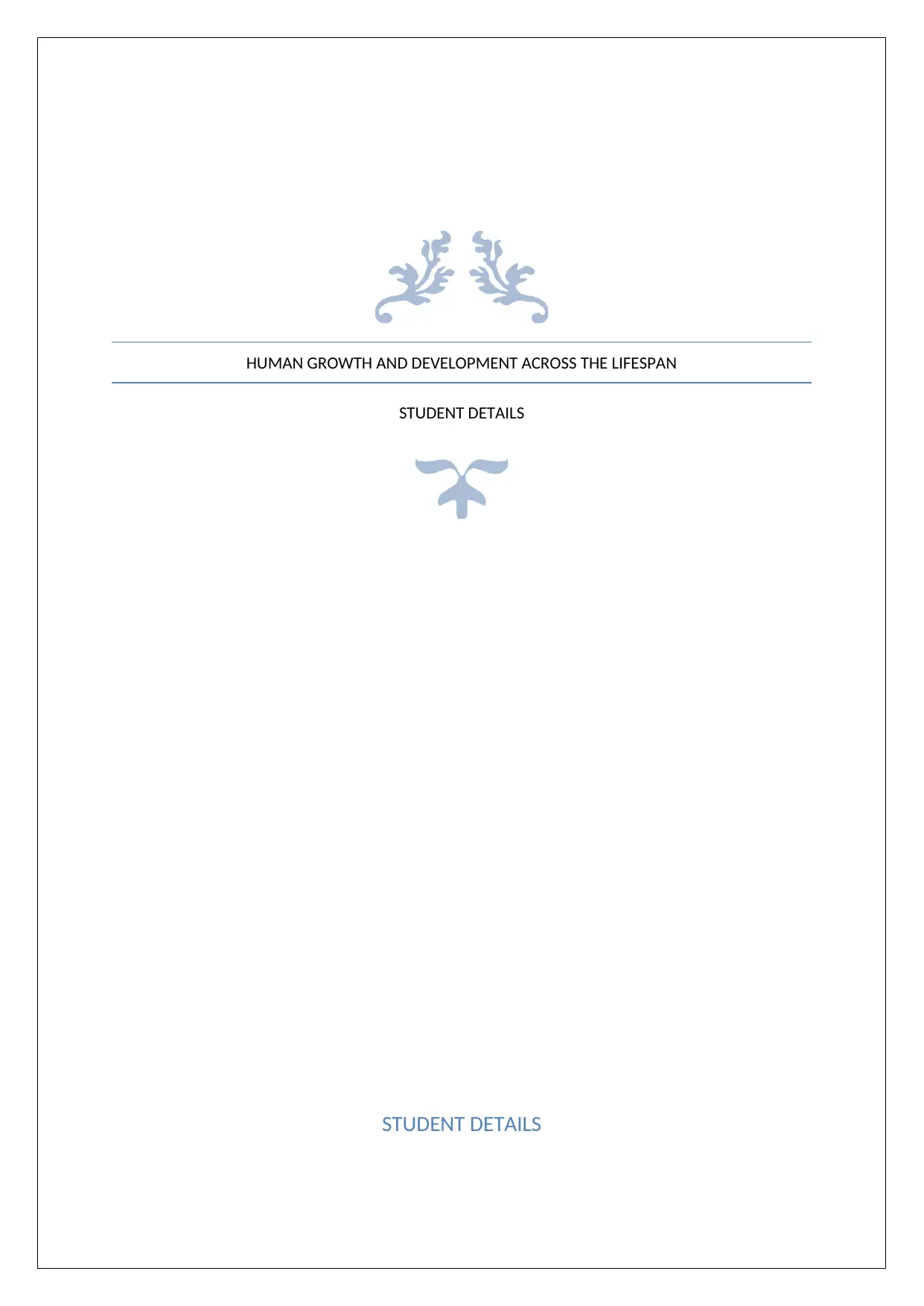
HUMAN GROWTH AND DEVELOPMENT ACROSS THE LIFESPAN
STUDENT DETAILS
STUDENT DETAILS
STUDENT DETAILS
STUDENT DETAILS
Secure Best Marks with AI Grader
Need help grading? Try our AI Grader for instant feedback on your assignments.
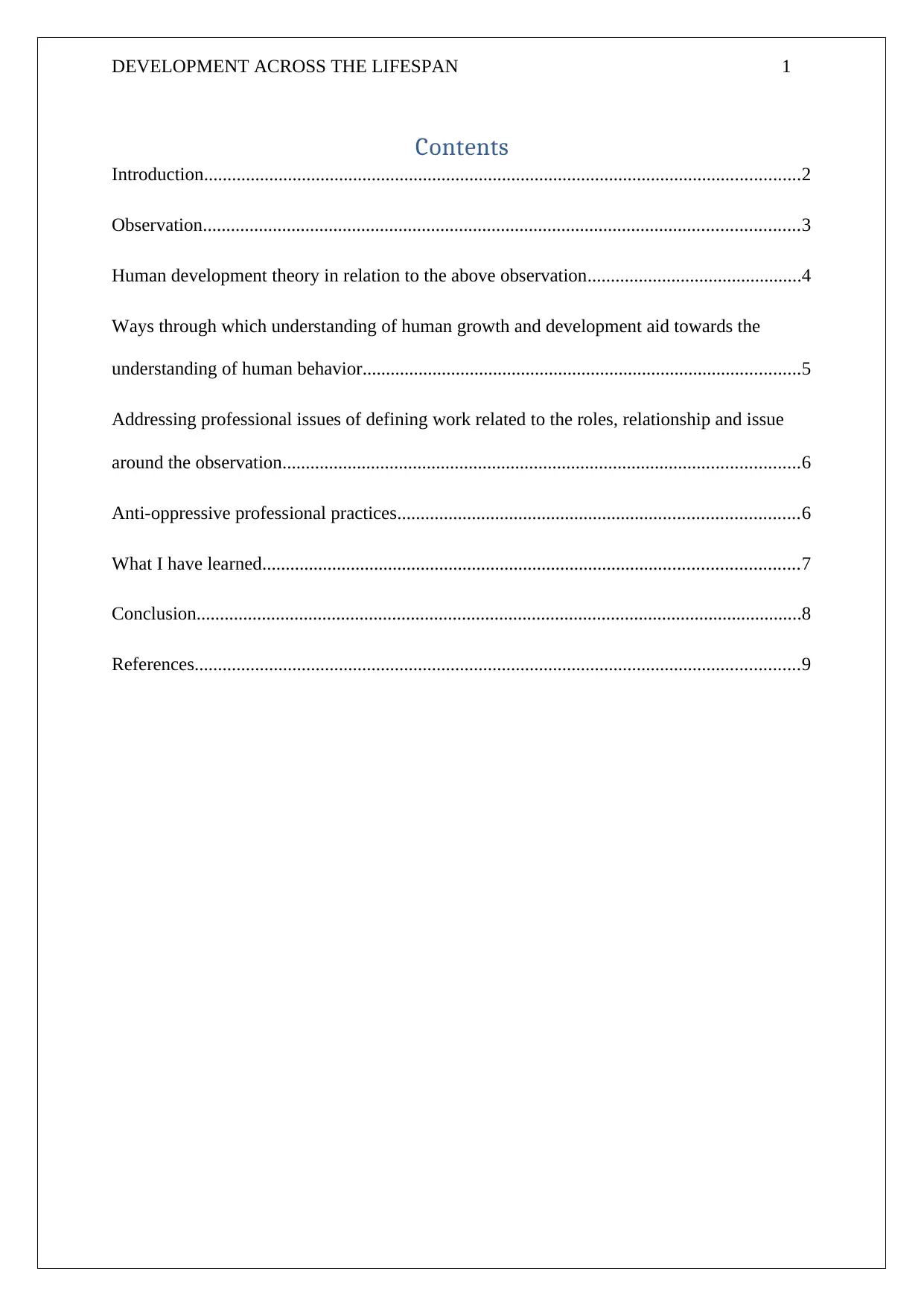
DEVELOPMENT ACROSS THE LIFESPAN 1
Contents
Introduction................................................................................................................................2
Observation................................................................................................................................3
Human development theory in relation to the above observation..............................................4
Ways through which understanding of human growth and development aid towards the
understanding of human behavior..............................................................................................5
Addressing professional issues of defining work related to the roles, relationship and issue
around the observation...............................................................................................................6
Anti-oppressive professional practices......................................................................................6
What I have learned...................................................................................................................7
Conclusion..................................................................................................................................8
References..................................................................................................................................9
Contents
Introduction................................................................................................................................2
Observation................................................................................................................................3
Human development theory in relation to the above observation..............................................4
Ways through which understanding of human growth and development aid towards the
understanding of human behavior..............................................................................................5
Addressing professional issues of defining work related to the roles, relationship and issue
around the observation...............................................................................................................6
Anti-oppressive professional practices......................................................................................6
What I have learned...................................................................................................................7
Conclusion..................................................................................................................................8
References..................................................................................................................................9
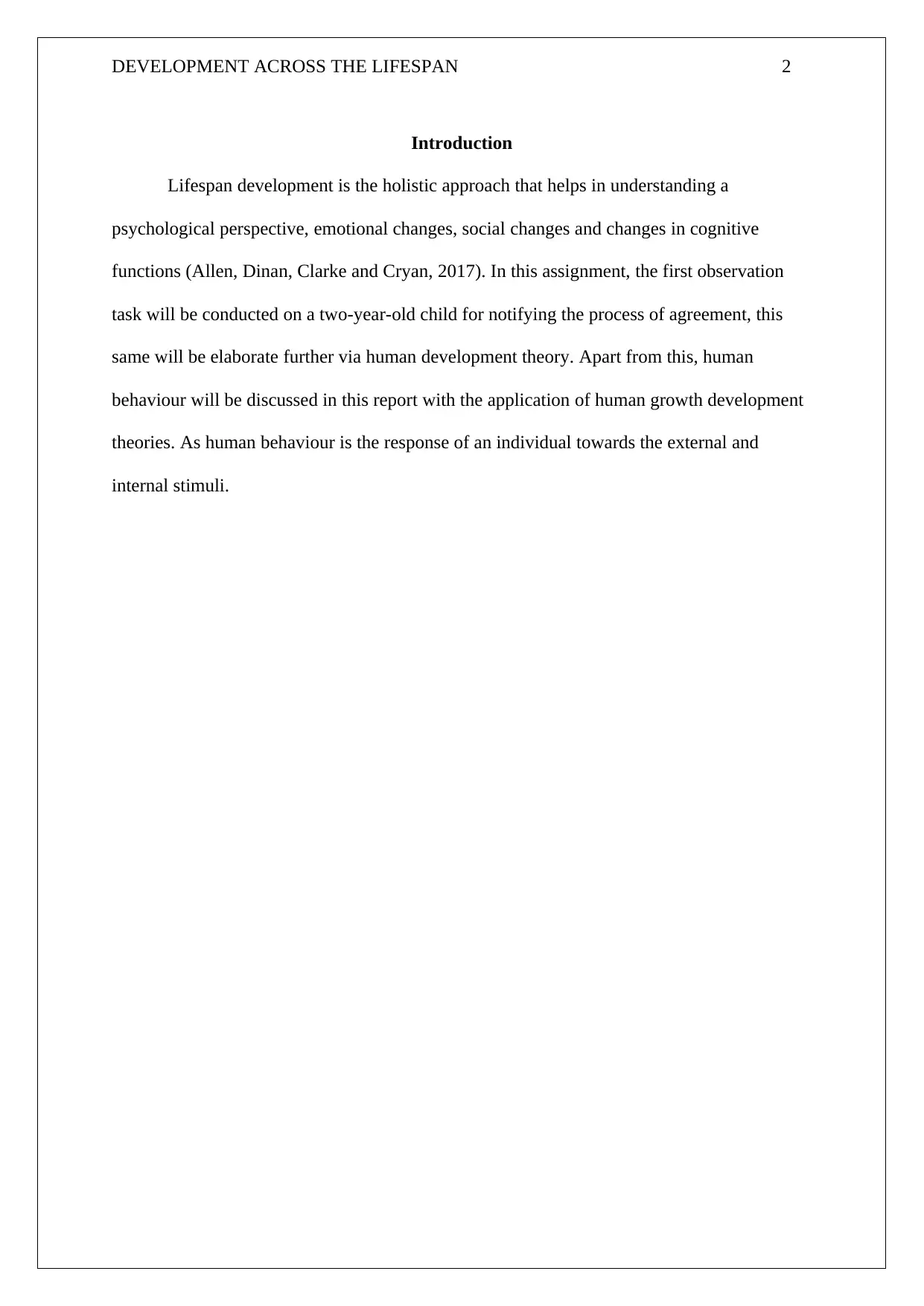
DEVELOPMENT ACROSS THE LIFESPAN 2
Introduction
Lifespan development is the holistic approach that helps in understanding a
psychological perspective, emotional changes, social changes and changes in cognitive
functions (Allen, Dinan, Clarke and Cryan, 2017). In this assignment, the first observation
task will be conducted on a two-year-old child for notifying the process of agreement, this
same will be elaborate further via human development theory. Apart from this, human
behaviour will be discussed in this report with the application of human growth development
theories. As human behaviour is the response of an individual towards the external and
internal stimuli.
Introduction
Lifespan development is the holistic approach that helps in understanding a
psychological perspective, emotional changes, social changes and changes in cognitive
functions (Allen, Dinan, Clarke and Cryan, 2017). In this assignment, the first observation
task will be conducted on a two-year-old child for notifying the process of agreement, this
same will be elaborate further via human development theory. Apart from this, human
behaviour will be discussed in this report with the application of human growth development
theories. As human behaviour is the response of an individual towards the external and
internal stimuli.
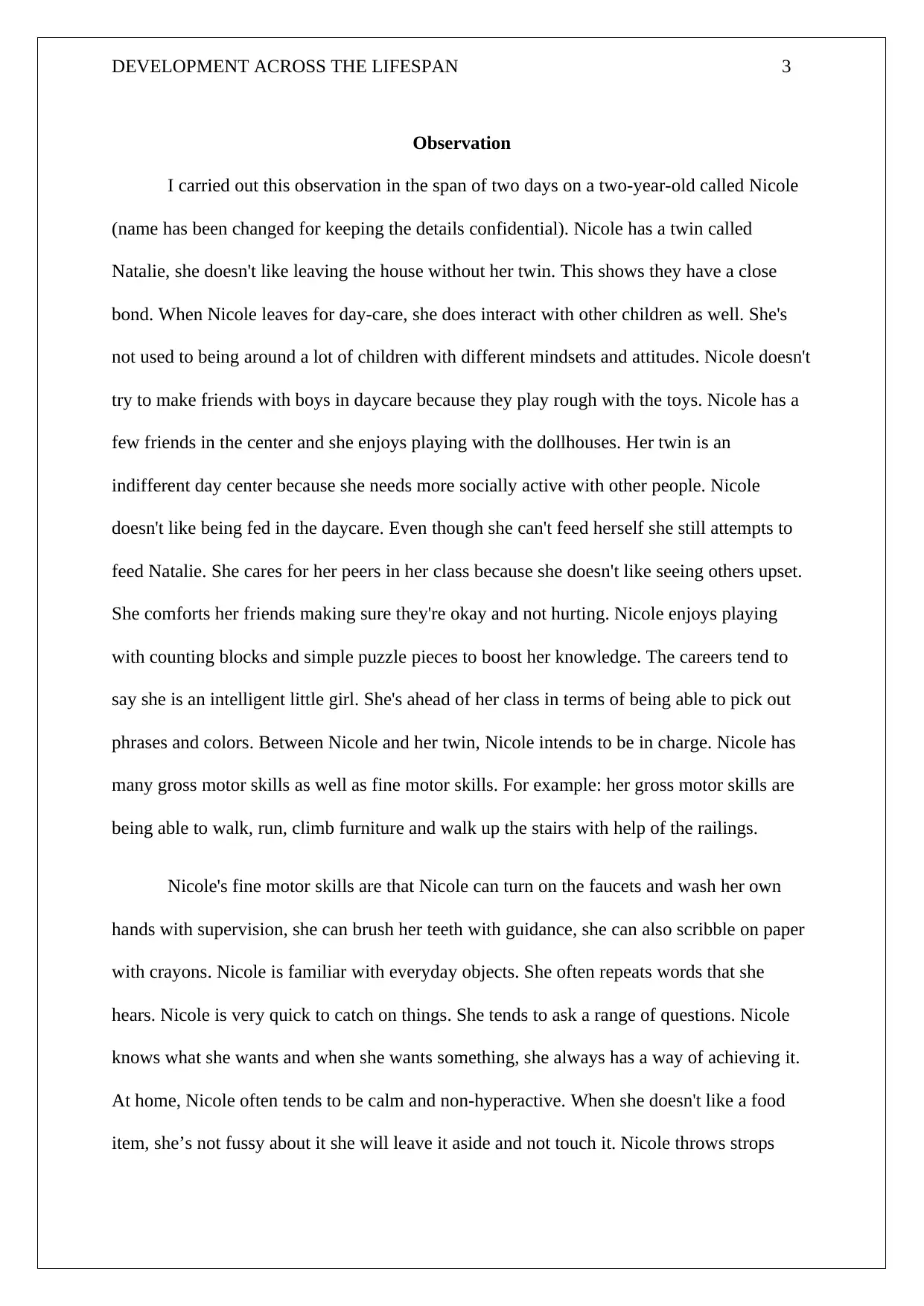
DEVELOPMENT ACROSS THE LIFESPAN 3
Observation
I carried out this observation in the span of two days on a two-year-old called Nicole
(name has been changed for keeping the details confidential). Nicole has a twin called
Natalie, she doesn't like leaving the house without her twin. This shows they have a close
bond. When Nicole leaves for day-care, she does interact with other children as well. She's
not used to being around a lot of children with different mindsets and attitudes. Nicole doesn't
try to make friends with boys in daycare because they play rough with the toys. Nicole has a
few friends in the center and she enjoys playing with the dollhouses. Her twin is an
indifferent day center because she needs more socially active with other people. Nicole
doesn't like being fed in the daycare. Even though she can't feed herself she still attempts to
feed Natalie. She cares for her peers in her class because she doesn't like seeing others upset.
She comforts her friends making sure they're okay and not hurting. Nicole enjoys playing
with counting blocks and simple puzzle pieces to boost her knowledge. The careers tend to
say she is an intelligent little girl. She's ahead of her class in terms of being able to pick out
phrases and colors. Between Nicole and her twin, Nicole intends to be in charge. Nicole has
many gross motor skills as well as fine motor skills. For example: her gross motor skills are
being able to walk, run, climb furniture and walk up the stairs with help of the railings.
Nicole's fine motor skills are that Nicole can turn on the faucets and wash her own
hands with supervision, she can brush her teeth with guidance, she can also scribble on paper
with crayons. Nicole is familiar with everyday objects. She often repeats words that she
hears. Nicole is very quick to catch on things. She tends to ask a range of questions. Nicole
knows what she wants and when she wants something, she always has a way of achieving it.
At home, Nicole often tends to be calm and non-hyperactive. When she doesn't like a food
item, she’s not fussy about it she will leave it aside and not touch it. Nicole throws strops
Observation
I carried out this observation in the span of two days on a two-year-old called Nicole
(name has been changed for keeping the details confidential). Nicole has a twin called
Natalie, she doesn't like leaving the house without her twin. This shows they have a close
bond. When Nicole leaves for day-care, she does interact with other children as well. She's
not used to being around a lot of children with different mindsets and attitudes. Nicole doesn't
try to make friends with boys in daycare because they play rough with the toys. Nicole has a
few friends in the center and she enjoys playing with the dollhouses. Her twin is an
indifferent day center because she needs more socially active with other people. Nicole
doesn't like being fed in the daycare. Even though she can't feed herself she still attempts to
feed Natalie. She cares for her peers in her class because she doesn't like seeing others upset.
She comforts her friends making sure they're okay and not hurting. Nicole enjoys playing
with counting blocks and simple puzzle pieces to boost her knowledge. The careers tend to
say she is an intelligent little girl. She's ahead of her class in terms of being able to pick out
phrases and colors. Between Nicole and her twin, Nicole intends to be in charge. Nicole has
many gross motor skills as well as fine motor skills. For example: her gross motor skills are
being able to walk, run, climb furniture and walk up the stairs with help of the railings.
Nicole's fine motor skills are that Nicole can turn on the faucets and wash her own
hands with supervision, she can brush her teeth with guidance, she can also scribble on paper
with crayons. Nicole is familiar with everyday objects. She often repeats words that she
hears. Nicole is very quick to catch on things. She tends to ask a range of questions. Nicole
knows what she wants and when she wants something, she always has a way of achieving it.
At home, Nicole often tends to be calm and non-hyperactive. When she doesn't like a food
item, she’s not fussy about it she will leave it aside and not touch it. Nicole throws strops
Secure Best Marks with AI Grader
Need help grading? Try our AI Grader for instant feedback on your assignments.
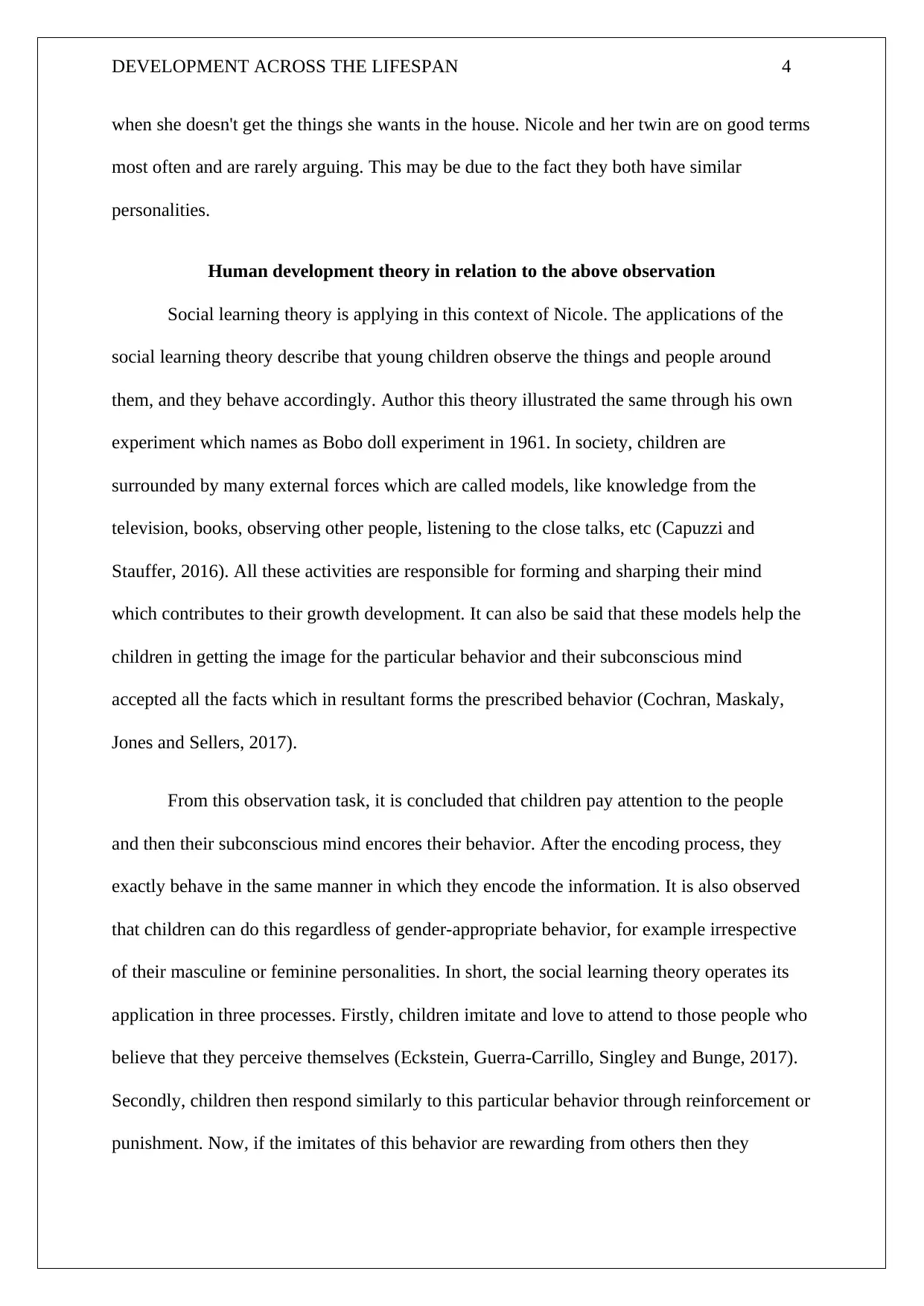
DEVELOPMENT ACROSS THE LIFESPAN 4
when she doesn't get the things she wants in the house. Nicole and her twin are on good terms
most often and are rarely arguing. This may be due to the fact they both have similar
personalities.
Human development theory in relation to the above observation
Social learning theory is applying in this context of Nicole. The applications of the
social learning theory describe that young children observe the things and people around
them, and they behave accordingly. Author this theory illustrated the same through his own
experiment which names as Bobo doll experiment in 1961. In society, children are
surrounded by many external forces which are called models, like knowledge from the
television, books, observing other people, listening to the close talks, etc (Capuzzi and
Stauffer, 2016). All these activities are responsible for forming and sharping their mind
which contributes to their growth development. It can also be said that these models help the
children in getting the image for the particular behavior and their subconscious mind
accepted all the facts which in resultant forms the prescribed behavior (Cochran, Maskaly,
Jones and Sellers, 2017).
From this observation task, it is concluded that children pay attention to the people
and then their subconscious mind encores their behavior. After the encoding process, they
exactly behave in the same manner in which they encode the information. It is also observed
that children can do this regardless of gender-appropriate behavior, for example irrespective
of their masculine or feminine personalities. In short, the social learning theory operates its
application in three processes. Firstly, children imitate and love to attend to those people who
believe that they perceive themselves (Eckstein, Guerra-Carrillo, Singley and Bunge, 2017).
Secondly, children then respond similarly to this particular behavior through reinforcement or
punishment. Now, if the imitates of this behavior are rewarding from others then they
when she doesn't get the things she wants in the house. Nicole and her twin are on good terms
most often and are rarely arguing. This may be due to the fact they both have similar
personalities.
Human development theory in relation to the above observation
Social learning theory is applying in this context of Nicole. The applications of the
social learning theory describe that young children observe the things and people around
them, and they behave accordingly. Author this theory illustrated the same through his own
experiment which names as Bobo doll experiment in 1961. In society, children are
surrounded by many external forces which are called models, like knowledge from the
television, books, observing other people, listening to the close talks, etc (Capuzzi and
Stauffer, 2016). All these activities are responsible for forming and sharping their mind
which contributes to their growth development. It can also be said that these models help the
children in getting the image for the particular behavior and their subconscious mind
accepted all the facts which in resultant forms the prescribed behavior (Cochran, Maskaly,
Jones and Sellers, 2017).
From this observation task, it is concluded that children pay attention to the people
and then their subconscious mind encores their behavior. After the encoding process, they
exactly behave in the same manner in which they encode the information. It is also observed
that children can do this regardless of gender-appropriate behavior, for example irrespective
of their masculine or feminine personalities. In short, the social learning theory operates its
application in three processes. Firstly, children imitate and love to attend to those people who
believe that they perceive themselves (Eckstein, Guerra-Carrillo, Singley and Bunge, 2017).
Secondly, children then respond similarly to this particular behavior through reinforcement or
punishment. Now, if the imitates of this behavior are rewarding from others then they
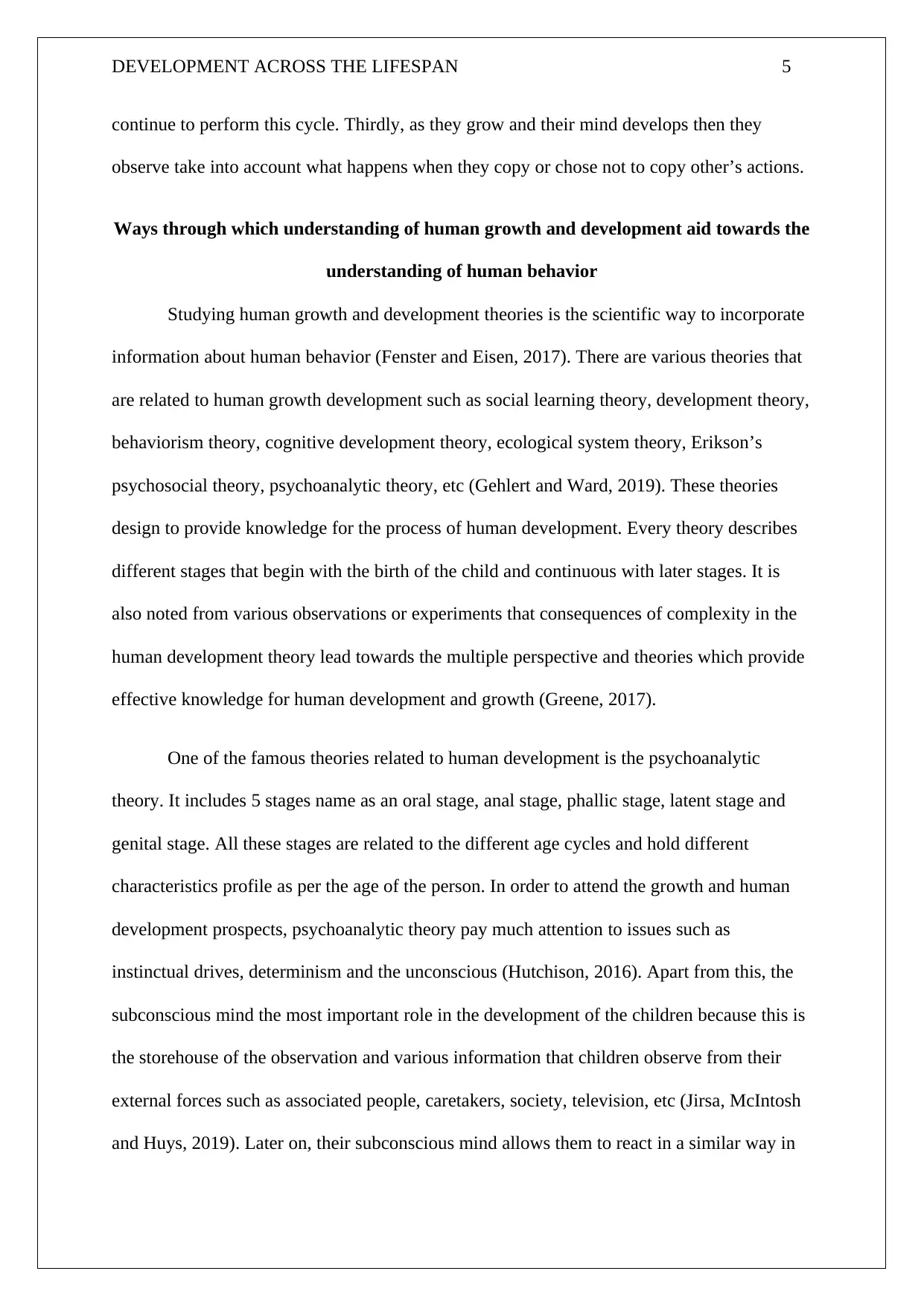
DEVELOPMENT ACROSS THE LIFESPAN 5
continue to perform this cycle. Thirdly, as they grow and their mind develops then they
observe take into account what happens when they copy or chose not to copy other’s actions.
Ways through which understanding of human growth and development aid towards the
understanding of human behavior
Studying human growth and development theories is the scientific way to incorporate
information about human behavior (Fenster and Eisen, 2017). There are various theories that
are related to human growth development such as social learning theory, development theory,
behaviorism theory, cognitive development theory, ecological system theory, Erikson’s
psychosocial theory, psychoanalytic theory, etc (Gehlert and Ward, 2019). These theories
design to provide knowledge for the process of human development. Every theory describes
different stages that begin with the birth of the child and continuous with later stages. It is
also noted from various observations or experiments that consequences of complexity in the
human development theory lead towards the multiple perspective and theories which provide
effective knowledge for human development and growth (Greene, 2017).
One of the famous theories related to human development is the psychoanalytic
theory. It includes 5 stages name as an oral stage, anal stage, phallic stage, latent stage and
genital stage. All these stages are related to the different age cycles and hold different
characteristics profile as per the age of the person. In order to attend the growth and human
development prospects, psychoanalytic theory pay much attention to issues such as
instinctual drives, determinism and the unconscious (Hutchison, 2016). Apart from this, the
subconscious mind the most important role in the development of the children because this is
the storehouse of the observation and various information that children observe from their
external forces such as associated people, caretakers, society, television, etc (Jirsa, McIntosh
and Huys, 2019). Later on, their subconscious mind allows them to react in a similar way in
continue to perform this cycle. Thirdly, as they grow and their mind develops then they
observe take into account what happens when they copy or chose not to copy other’s actions.
Ways through which understanding of human growth and development aid towards the
understanding of human behavior
Studying human growth and development theories is the scientific way to incorporate
information about human behavior (Fenster and Eisen, 2017). There are various theories that
are related to human growth development such as social learning theory, development theory,
behaviorism theory, cognitive development theory, ecological system theory, Erikson’s
psychosocial theory, psychoanalytic theory, etc (Gehlert and Ward, 2019). These theories
design to provide knowledge for the process of human development. Every theory describes
different stages that begin with the birth of the child and continuous with later stages. It is
also noted from various observations or experiments that consequences of complexity in the
human development theory lead towards the multiple perspective and theories which provide
effective knowledge for human development and growth (Greene, 2017).
One of the famous theories related to human development is the psychoanalytic
theory. It includes 5 stages name as an oral stage, anal stage, phallic stage, latent stage and
genital stage. All these stages are related to the different age cycles and hold different
characteristics profile as per the age of the person. In order to attend the growth and human
development prospects, psychoanalytic theory pay much attention to issues such as
instinctual drives, determinism and the unconscious (Hutchison, 2016). Apart from this, the
subconscious mind the most important role in the development of the children because this is
the storehouse of the observation and various information that children observe from their
external forces such as associated people, caretakers, society, television, etc (Jirsa, McIntosh
and Huys, 2019). Later on, their subconscious mind allows them to react in a similar way in
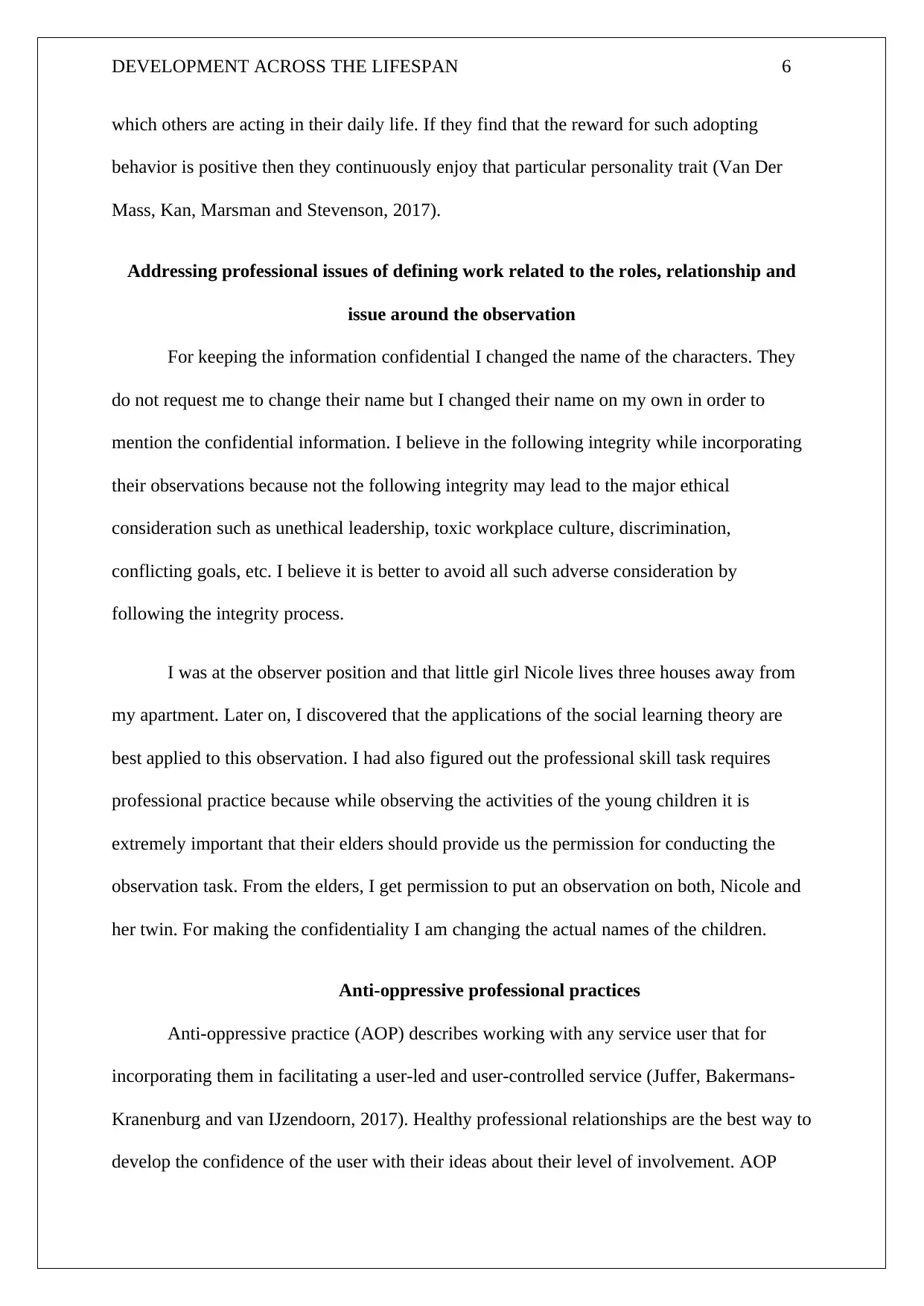
DEVELOPMENT ACROSS THE LIFESPAN 6
which others are acting in their daily life. If they find that the reward for such adopting
behavior is positive then they continuously enjoy that particular personality trait (Van Der
Mass, Kan, Marsman and Stevenson, 2017).
Addressing professional issues of defining work related to the roles, relationship and
issue around the observation
For keeping the information confidential I changed the name of the characters. They
do not request me to change their name but I changed their name on my own in order to
mention the confidential information. I believe in the following integrity while incorporating
their observations because not the following integrity may lead to the major ethical
consideration such as unethical leadership, toxic workplace culture, discrimination,
conflicting goals, etc. I believe it is better to avoid all such adverse consideration by
following the integrity process.
I was at the observer position and that little girl Nicole lives three houses away from
my apartment. Later on, I discovered that the applications of the social learning theory are
best applied to this observation. I had also figured out the professional skill task requires
professional practice because while observing the activities of the young children it is
extremely important that their elders should provide us the permission for conducting the
observation task. From the elders, I get permission to put an observation on both, Nicole and
her twin. For making the confidentiality I am changing the actual names of the children.
Anti-oppressive professional practices
Anti-oppressive practice (AOP) describes working with any service user that for
incorporating them in facilitating a user-led and user-controlled service (Juffer, Bakermans-
Kranenburg and van IJzendoorn, 2017). Healthy professional relationships are the best way to
develop the confidence of the user with their ideas about their level of involvement. AOP
which others are acting in their daily life. If they find that the reward for such adopting
behavior is positive then they continuously enjoy that particular personality trait (Van Der
Mass, Kan, Marsman and Stevenson, 2017).
Addressing professional issues of defining work related to the roles, relationship and
issue around the observation
For keeping the information confidential I changed the name of the characters. They
do not request me to change their name but I changed their name on my own in order to
mention the confidential information. I believe in the following integrity while incorporating
their observations because not the following integrity may lead to the major ethical
consideration such as unethical leadership, toxic workplace culture, discrimination,
conflicting goals, etc. I believe it is better to avoid all such adverse consideration by
following the integrity process.
I was at the observer position and that little girl Nicole lives three houses away from
my apartment. Later on, I discovered that the applications of the social learning theory are
best applied to this observation. I had also figured out the professional skill task requires
professional practice because while observing the activities of the young children it is
extremely important that their elders should provide us the permission for conducting the
observation task. From the elders, I get permission to put an observation on both, Nicole and
her twin. For making the confidentiality I am changing the actual names of the children.
Anti-oppressive professional practices
Anti-oppressive practice (AOP) describes working with any service user that for
incorporating them in facilitating a user-led and user-controlled service (Juffer, Bakermans-
Kranenburg and van IJzendoorn, 2017). Healthy professional relationships are the best way to
develop the confidence of the user with their ideas about their level of involvement. AOP
Paraphrase This Document
Need a fresh take? Get an instant paraphrase of this document with our AI Paraphraser
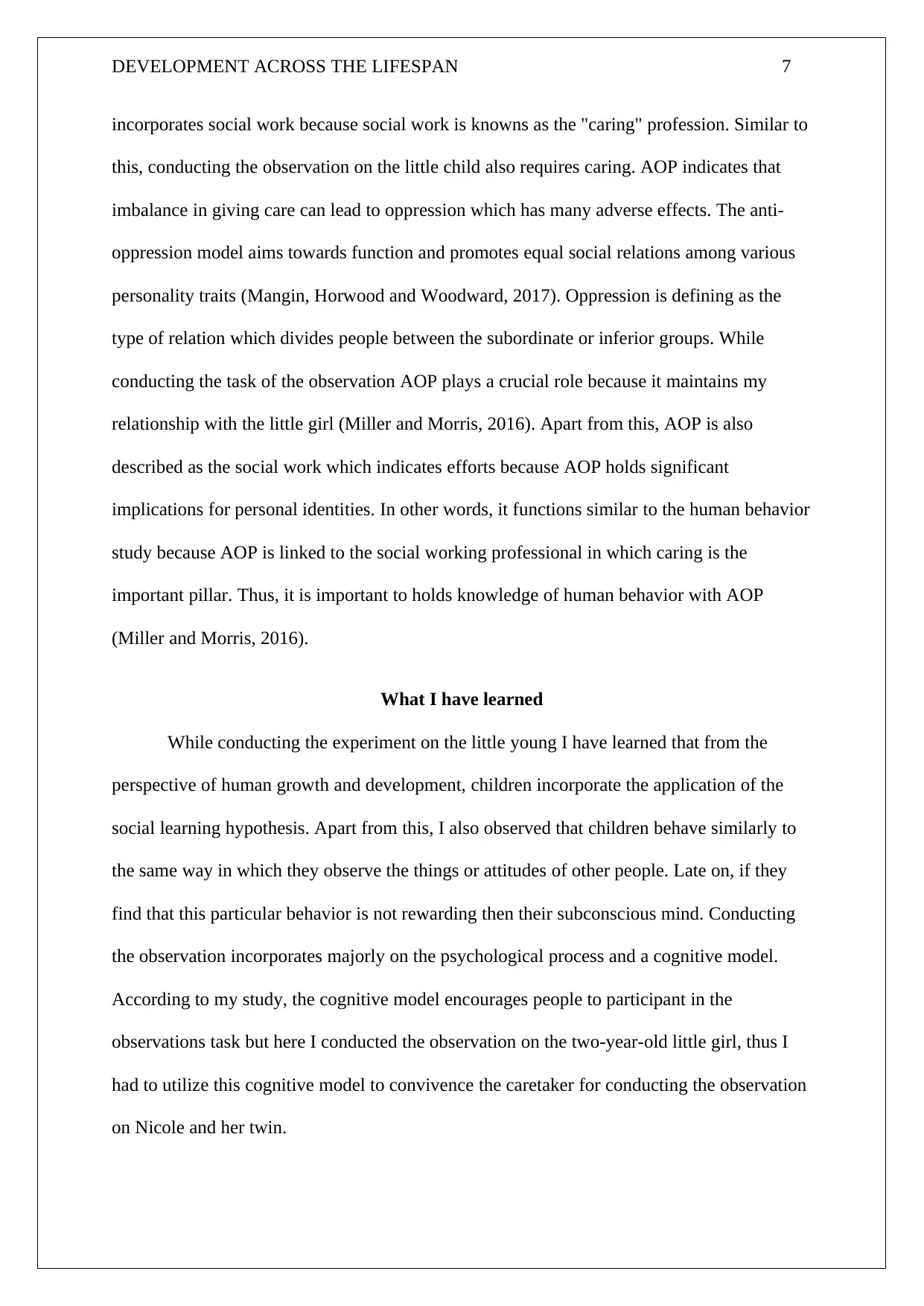
DEVELOPMENT ACROSS THE LIFESPAN 7
incorporates social work because social work is knowns as the "caring" profession. Similar to
this, conducting the observation on the little child also requires caring. AOP indicates that
imbalance in giving care can lead to oppression which has many adverse effects. The anti-
oppression model aims towards function and promotes equal social relations among various
personality traits (Mangin, Horwood and Woodward, 2017). Oppression is defining as the
type of relation which divides people between the subordinate or inferior groups. While
conducting the task of the observation AOP plays a crucial role because it maintains my
relationship with the little girl (Miller and Morris, 2016). Apart from this, AOP is also
described as the social work which indicates efforts because AOP holds significant
implications for personal identities. In other words, it functions similar to the human behavior
study because AOP is linked to the social working professional in which caring is the
important pillar. Thus, it is important to holds knowledge of human behavior with AOP
(Miller and Morris, 2016).
What I have learned
While conducting the experiment on the little young I have learned that from the
perspective of human growth and development, children incorporate the application of the
social learning hypothesis. Apart from this, I also observed that children behave similarly to
the same way in which they observe the things or attitudes of other people. Late on, if they
find that this particular behavior is not rewarding then their subconscious mind. Conducting
the observation incorporates majorly on the psychological process and a cognitive model.
According to my study, the cognitive model encourages people to participant in the
observations task but here I conducted the observation on the two-year-old little girl, thus I
had to utilize this cognitive model to convivence the caretaker for conducting the observation
on Nicole and her twin.
incorporates social work because social work is knowns as the "caring" profession. Similar to
this, conducting the observation on the little child also requires caring. AOP indicates that
imbalance in giving care can lead to oppression which has many adverse effects. The anti-
oppression model aims towards function and promotes equal social relations among various
personality traits (Mangin, Horwood and Woodward, 2017). Oppression is defining as the
type of relation which divides people between the subordinate or inferior groups. While
conducting the task of the observation AOP plays a crucial role because it maintains my
relationship with the little girl (Miller and Morris, 2016). Apart from this, AOP is also
described as the social work which indicates efforts because AOP holds significant
implications for personal identities. In other words, it functions similar to the human behavior
study because AOP is linked to the social working professional in which caring is the
important pillar. Thus, it is important to holds knowledge of human behavior with AOP
(Miller and Morris, 2016).
What I have learned
While conducting the experiment on the little young I have learned that from the
perspective of human growth and development, children incorporate the application of the
social learning hypothesis. Apart from this, I also observed that children behave similarly to
the same way in which they observe the things or attitudes of other people. Late on, if they
find that this particular behavior is not rewarding then their subconscious mind. Conducting
the observation incorporates majorly on the psychological process and a cognitive model.
According to my study, the cognitive model encourages people to participant in the
observations task but here I conducted the observation on the two-year-old little girl, thus I
had to utilize this cognitive model to convivence the caretaker for conducting the observation
on Nicole and her twin.
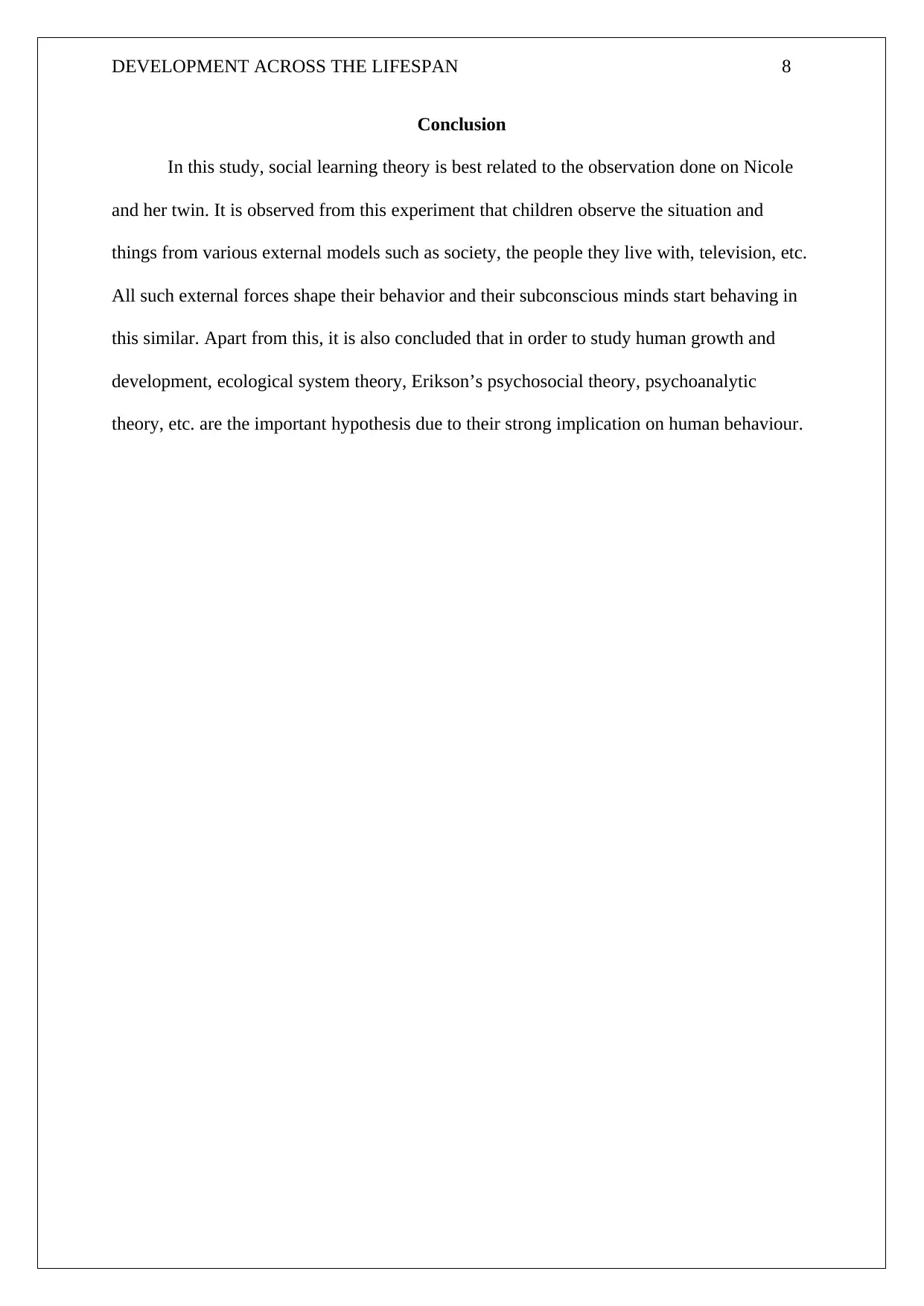
DEVELOPMENT ACROSS THE LIFESPAN 8
Conclusion
In this study, social learning theory is best related to the observation done on Nicole
and her twin. It is observed from this experiment that children observe the situation and
things from various external models such as society, the people they live with, television, etc.
All such external forces shape their behavior and their subconscious minds start behaving in
this similar. Apart from this, it is also concluded that in order to study human growth and
development, ecological system theory, Erikson’s psychosocial theory, psychoanalytic
theory, etc. are the important hypothesis due to their strong implication on human behaviour.
Conclusion
In this study, social learning theory is best related to the observation done on Nicole
and her twin. It is observed from this experiment that children observe the situation and
things from various external models such as society, the people they live with, television, etc.
All such external forces shape their behavior and their subconscious minds start behaving in
this similar. Apart from this, it is also concluded that in order to study human growth and
development, ecological system theory, Erikson’s psychosocial theory, psychoanalytic
theory, etc. are the important hypothesis due to their strong implication on human behaviour.
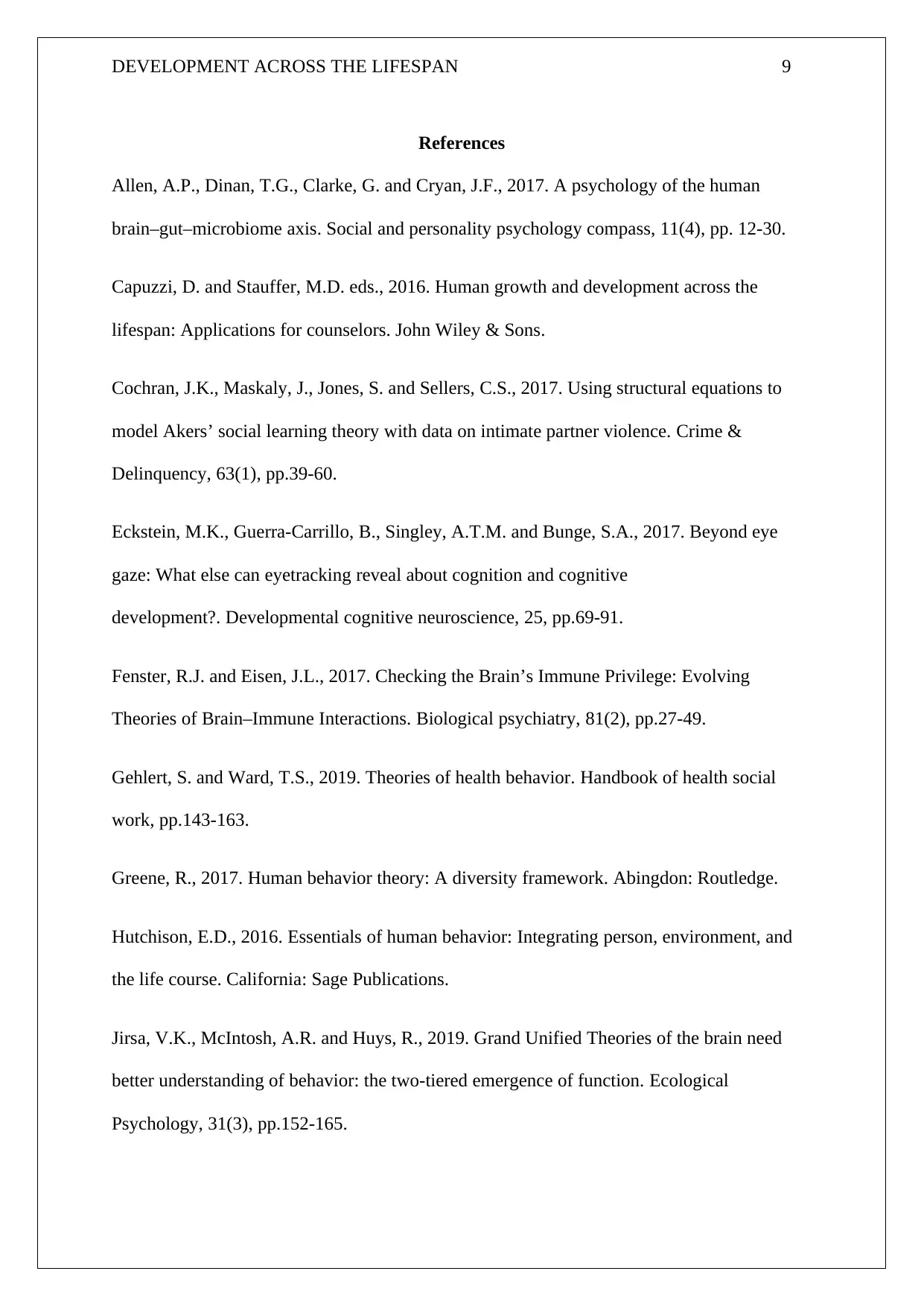
DEVELOPMENT ACROSS THE LIFESPAN 9
References
Allen, A.P., Dinan, T.G., Clarke, G. and Cryan, J.F., 2017. A psychology of the human
brain–gut–microbiome axis. Social and personality psychology compass, 11(4), pp. 12-30.
Capuzzi, D. and Stauffer, M.D. eds., 2016. Human growth and development across the
lifespan: Applications for counselors. John Wiley & Sons.
Cochran, J.K., Maskaly, J., Jones, S. and Sellers, C.S., 2017. Using structural equations to
model Akers’ social learning theory with data on intimate partner violence. Crime &
Delinquency, 63(1), pp.39-60.
Eckstein, M.K., Guerra-Carrillo, B., Singley, A.T.M. and Bunge, S.A., 2017. Beyond eye
gaze: What else can eyetracking reveal about cognition and cognitive
development?. Developmental cognitive neuroscience, 25, pp.69-91.
Fenster, R.J. and Eisen, J.L., 2017. Checking the Brain’s Immune Privilege: Evolving
Theories of Brain–Immune Interactions. Biological psychiatry, 81(2), pp.27-49.
Gehlert, S. and Ward, T.S., 2019. Theories of health behavior. Handbook of health social
work, pp.143-163.
Greene, R., 2017. Human behavior theory: A diversity framework. Abingdon: Routledge.
Hutchison, E.D., 2016. Essentials of human behavior: Integrating person, environment, and
the life course. California: Sage Publications.
Jirsa, V.K., McIntosh, A.R. and Huys, R., 2019. Grand Unified Theories of the brain need
better understanding of behavior: the two-tiered emergence of function. Ecological
Psychology, 31(3), pp.152-165.
References
Allen, A.P., Dinan, T.G., Clarke, G. and Cryan, J.F., 2017. A psychology of the human
brain–gut–microbiome axis. Social and personality psychology compass, 11(4), pp. 12-30.
Capuzzi, D. and Stauffer, M.D. eds., 2016. Human growth and development across the
lifespan: Applications for counselors. John Wiley & Sons.
Cochran, J.K., Maskaly, J., Jones, S. and Sellers, C.S., 2017. Using structural equations to
model Akers’ social learning theory with data on intimate partner violence. Crime &
Delinquency, 63(1), pp.39-60.
Eckstein, M.K., Guerra-Carrillo, B., Singley, A.T.M. and Bunge, S.A., 2017. Beyond eye
gaze: What else can eyetracking reveal about cognition and cognitive
development?. Developmental cognitive neuroscience, 25, pp.69-91.
Fenster, R.J. and Eisen, J.L., 2017. Checking the Brain’s Immune Privilege: Evolving
Theories of Brain–Immune Interactions. Biological psychiatry, 81(2), pp.27-49.
Gehlert, S. and Ward, T.S., 2019. Theories of health behavior. Handbook of health social
work, pp.143-163.
Greene, R., 2017. Human behavior theory: A diversity framework. Abingdon: Routledge.
Hutchison, E.D., 2016. Essentials of human behavior: Integrating person, environment, and
the life course. California: Sage Publications.
Jirsa, V.K., McIntosh, A.R. and Huys, R., 2019. Grand Unified Theories of the brain need
better understanding of behavior: the two-tiered emergence of function. Ecological
Psychology, 31(3), pp.152-165.
Secure Best Marks with AI Grader
Need help grading? Try our AI Grader for instant feedback on your assignments.
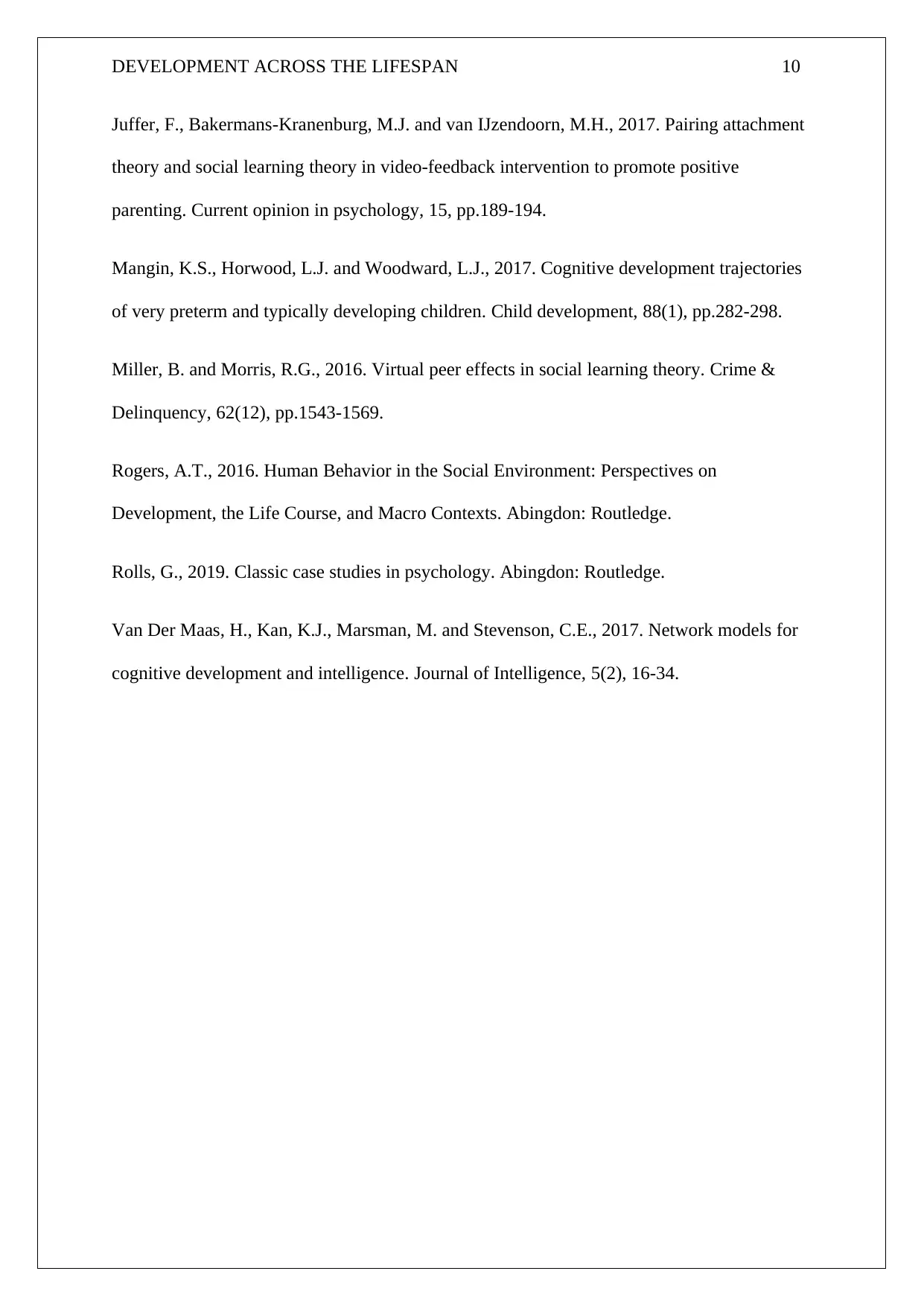
DEVELOPMENT ACROSS THE LIFESPAN 10
Juffer, F., Bakermans-Kranenburg, M.J. and van IJzendoorn, M.H., 2017. Pairing attachment
theory and social learning theory in video-feedback intervention to promote positive
parenting. Current opinion in psychology, 15, pp.189-194.
Mangin, K.S., Horwood, L.J. and Woodward, L.J., 2017. Cognitive development trajectories
of very preterm and typically developing children. Child development, 88(1), pp.282-298.
Miller, B. and Morris, R.G., 2016. Virtual peer effects in social learning theory. Crime &
Delinquency, 62(12), pp.1543-1569.
Rogers, A.T., 2016. Human Behavior in the Social Environment: Perspectives on
Development, the Life Course, and Macro Contexts. Abingdon: Routledge.
Rolls, G., 2019. Classic case studies in psychology. Abingdon: Routledge.
Van Der Maas, H., Kan, K.J., Marsman, M. and Stevenson, C.E., 2017. Network models for
cognitive development and intelligence. Journal of Intelligence, 5(2), 16-34.
Juffer, F., Bakermans-Kranenburg, M.J. and van IJzendoorn, M.H., 2017. Pairing attachment
theory and social learning theory in video-feedback intervention to promote positive
parenting. Current opinion in psychology, 15, pp.189-194.
Mangin, K.S., Horwood, L.J. and Woodward, L.J., 2017. Cognitive development trajectories
of very preterm and typically developing children. Child development, 88(1), pp.282-298.
Miller, B. and Morris, R.G., 2016. Virtual peer effects in social learning theory. Crime &
Delinquency, 62(12), pp.1543-1569.
Rogers, A.T., 2016. Human Behavior in the Social Environment: Perspectives on
Development, the Life Course, and Macro Contexts. Abingdon: Routledge.
Rolls, G., 2019. Classic case studies in psychology. Abingdon: Routledge.
Van Der Maas, H., Kan, K.J., Marsman, M. and Stevenson, C.E., 2017. Network models for
cognitive development and intelligence. Journal of Intelligence, 5(2), 16-34.
1 out of 11
Your All-in-One AI-Powered Toolkit for Academic Success.
+13062052269
info@desklib.com
Available 24*7 on WhatsApp / Email
![[object Object]](/_next/static/media/star-bottom.7253800d.svg)
Unlock your academic potential
© 2024 | Zucol Services PVT LTD | All rights reserved.
